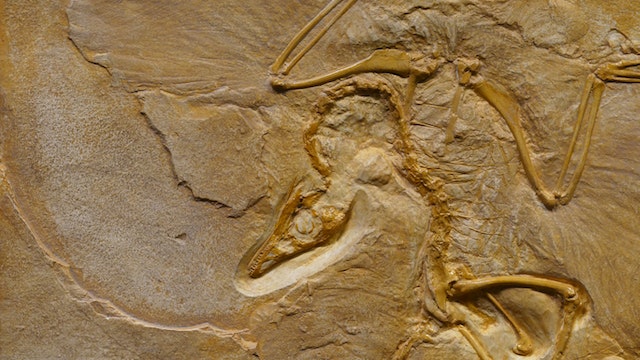
How do fossils form? They form when the bones of an animal are turned to mineral.
A fossil forms when an animal dies in water or falls into water. This water is more commonly an ocean or a lake because for a fossil to form, the sediment at the bottom of the water has to be still. Unless it is exceptionally deep, a river is too fast flowing and the sediment gets mixed up.
The animal sinks to the bottom of the water and the fleshy parts of the animal decompose, leaving the bones. Thick layers of sediment build up on top of the animal’s bones. This protects the bones from animals that might move them and from any currents that there might be in the water. Once the sediment is deep enough, groundwater starts to flow through it and through the bones of the animal. The ground water carries dissolved minerals and these slowly start to accumulate in the spaces in the bones. The dissolved minerals crystalize and form rock in the same shape as the bones. It can take 10,000 or more years for this process to happen. This process is called permineralization. More and more sediment builds up over the bones and the pressure turns the sediment around the bones into rock. This type of rock is called, unsurprisingly, sedimentary rock.
Permineralization can also happen with plants. When a plant sinks to the bottom of a lake or the sea, it can get covered in mud and minerals can flow through it and get trapped in the cells of the plant before it has time to decompose. For this to happen, the plant needs to be covered in a thick layer of mud that cuts off most of the oxygen to the plant because it is the oxygen that the bacteria need for the plant to decompose. Plant fossils can be found, but they are rarer than animal fossils.
If all of the fossils in the world were at the bottom of seas, we wouldn’t have found any of them. So, how do they get to the surface? This is down to plate tectonics. The plates on the surface of the Earth move. Some plates slide under other plates. When they slide down, they can create an ocean, when they slide up, they can create mountains. The continents move around with them and areas that were once seas dry up and become land. The fossils that were at the bottom of the sea are now on the surface.
So, are the only fossils we find those of sea animals and some plants? In the large part yes. Sea animals, or animals that have fallen into lakes. The animals also need to have a skeleton or a hard shell for permineralization to take place. Plants need to be covered by the right kind of mud. The majority of fossils are these, which does skewer the fossil record somewhat. Animals that die on land don’t get covered by anything and cannot become fossils. The majority of lifeforms were probably insects and it is very difficult to find fossils of those.
However, there are two other ways that fossils can form. One of these is amber. If you have seen Jurassic Park, then you know about this because the whole plot of the movie is dependent on a mosquito found preserved in amber. Amber fossils are rarer than mineral fossils. Amber is made from tree resin. An insect may sit on a tree and get covered in tree resin The resin falls off the tree with the insect in it and lands on wet soil. If it lands on dry soil, it will disintegrate. Then it must be washed into a lake or a sea where it is covered in sediment in the same way as mineral fossils. This is why they are rare. The great thing about amber fossils is that they preserve the insect exactly. The fleshy parts don’t decompose.
The other way fossils can form is with impressions. Most soft animals, like jellyfish, that die don’t have a skeleton and cannot become fossils, However, sometimes they might land on soft mud and more soft mud might land over them before they can decompose. This soft mud stops them from decomposing for long enough for an impression of the animal or plant to form. Minerals then flow into the impression and make rock. These fossils are very rare.
So, how do fossils form? They either form when their bones get turned into rock, if they are trapped in amber, or if an impression of them is left. And this is what I learned today.
Sources
http://www.curiousmeerkat.co.uk/debunking/how-long-fossilisation-take/
https://australian.museum/learn/australia-over-time/fossils/how-do-fossils-form/

Pingback: #413 Why are diamonds so expensive? - I Learned This Today